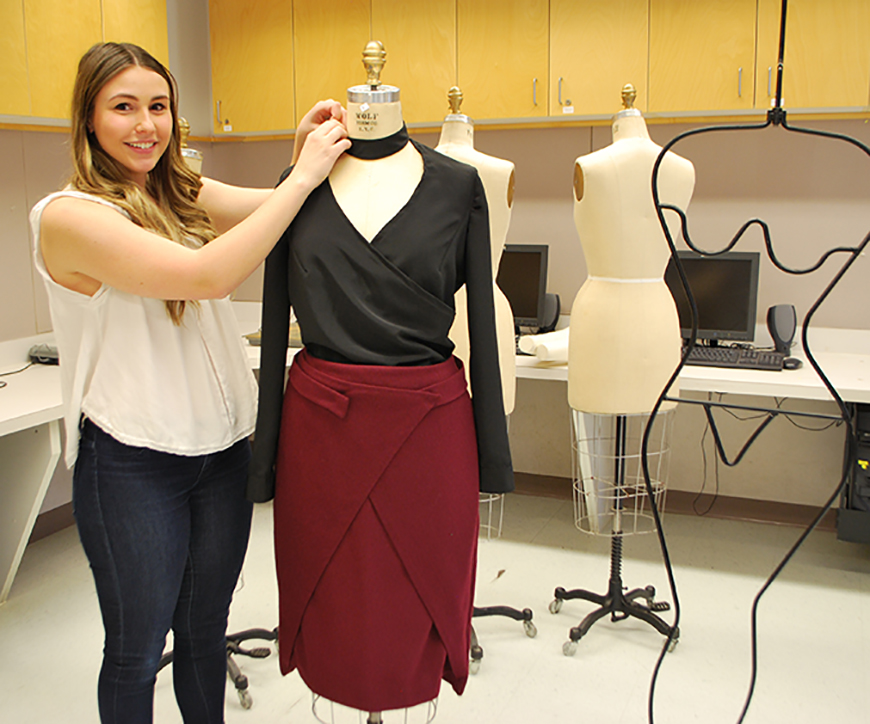
Details like a potentially detachable choker-collar and a skirt with asymmetrical panels were designed so that the outfit appeals to a range of ages.
Lauren Degenstein could fill a clothesline with the many items that challenged her on the way to winning a significant award for student fashion designers.
For starters, the fourth-year student in the Department of Human Ecology's stream for clothing, textiles and material culture had only taken one sewing class prior to producing her entry, a graceful skirt and blouse designed for office settings but cleverly adaptable to evening fun.
"I wanted something that people are going to want to wear, that's trendy and professional, and not too hard draw because I was required to make my own pattern," she said.
Added to that, the rules for this year's Telio Scholarship stipulated that competitors demonstrate some grasp of the business end of the fashion industry, although the Montreal manufacturer sponsoring the $1,000 award left the specifics of how to do that up to instructors at each Canadian design school where it offered a prize. To fulfil this requirement, Vlada Blinova, who teaches the apparel design and product development course at the University of Alberta, asked her students to include a detailed business and marketing plan.
Since she's part of a generation acutely aware of the fragility of the environment it is inheriting, Degenstein also believes in sustainable fashion-clothes that won't soon be clogging a landfill.
"So I decided to design investment pieces that people maybe would spend more money on, but that last a while," she said.
That decision made her entry even trickier to execute, because in her business plan Degenstein targeted young women just entering the workforce who have modest budgets for their career wardrobes-and by definition, investment pieces require a financial commitment.
Finally, she wanted the outfit to please women who share her own taste, and this soft-spoken woman is not partial to bright colours.
Her winning result exudes elegance and engaging niceties, an apt reflection of Degenstein and her dazzling smile.
The outfit's muted burgundy, wool-blend skirt is cut asymmetrically with extra front panels that provide sharp decorative lines when fastened, or drape softly to the sides when undone. A removable, also asymmetric, fabric belt creates an attention-drawing detail, as does the slightly longer length of the skirt's back panel.
The top is a curvily structured black blouse of polyester that either tucks into the skirt's high waistband in relaxed waves, or floats over the hips. Its V-neck flatters many upper-body shapes, and its built-in choker (which could be modified to be removable) adds a bit of bohemian chic.
The top might easily pair with jeans, just as the skirt could confidently accompany a dressier or more revealing top.
"It's simple, sophisticated and can be adapted for different age groups," said Blinova, one of the several instructors of human ecology who judged it the winner.
Spurred on by just that advice from Blinova-to make the outfit appealing to women from their 20s through their 50s-Degenstein was able to justify the extra fabric required in the skirt and build a strong business case.
However, her design did require the mind of a jigsaw-puzzle designer. Unlike typical clothing construction, which allows the sewer to hem a garment after all its sections are put together, to achieve the smooth, high-end finish she sought for her target clients Degenstein blind-stitched the hems of the panels before they went together. That meant keeping many variables in mind as she worked, so that everything aligned in the end.
Such 360-degree thinking is exactly what attracted this former psychology student to human ecology studies and eventually, she hopes, to a career producing protective clothing.
"Human ecology bases itself on a holistic approach to everything," she said. "You get to see all sides of an issue. You see the impact on the environmental side, the business side, the interactions of people and their clothing.
"I used to be a compulsive buyer (of clothing), thinking, 'Oh maybe I'll have an occasion to wear this.' Now, I really think, 'Do I love this? Am I going to wear this for years to come?' Definitely the program has opened my eyes to that."